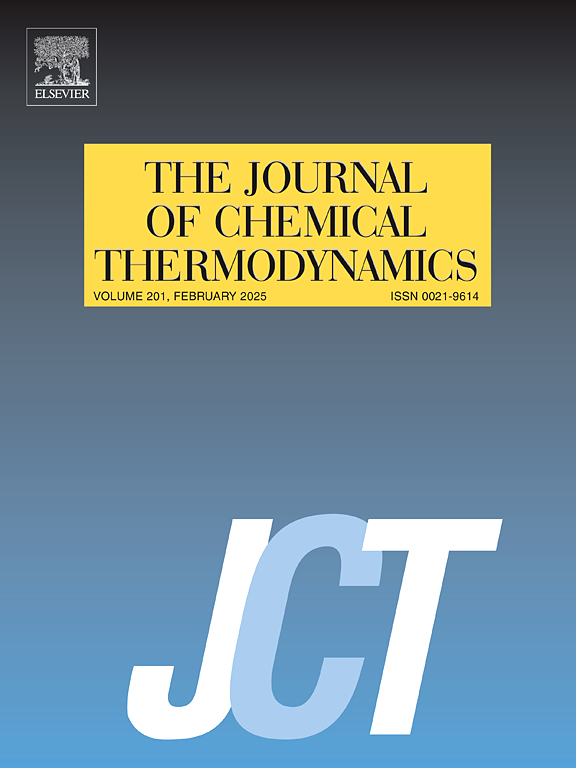Solubility measurement, correlation, thermodynamic properties, and solvent effect of metronidazole in seven pure solvents and two binary solvent systems
IF 2.2
3区 工程技术
Q3 CHEMISTRY, PHYSICAL
引用次数: 0
Abstract
Solubility and thermodynamic properties of metronidazole (MET) in different solvents are important for the separation and optimization of particle shape in crystallization processes. In this study, the solubility of MET in 7 mono-solvents (methanol, ethanol, i-propanol, n-butanol, ethyl acetate, chloroform, water) and 2 binary solvent systems (methanol + water, and ethanol + water) was determined by using gravimetric method within the temperature range from 293.15 to 327.35 K under atmospheric pressure. The sequence of mole fraction solubility of MET in the studied mono-solvent is methanol > n-butanol > ethanol > i-propanol > ethyl acetate > chloroform > water, and the solubility increases monotonically with increasing temperature. For 2 binary solvent systems, the solubilities increased with increasing temperature for fixed solvent compositions, but for situation of fixed temperature, and the solubilities would reach a maximum value for mole fraction of methanol in methanol + water is 0.6999 and for mole fraction of ethanol is 0.5994. The model calibration of the solubility data in 7 mono-solvents were investigated using the modified Apelblat equation, λh equation, non-random two-liquid (NRTL) model and Wilson model, and the solubility data of MET in methanol + water and ethanol + water were also modeled using van’t Hoff-Jouyban Acree model, modified Apelblat-Jouyban-Acree equation except for these five thermodynamic models used for 7 mono-solvents. The relative average deviations for the experimental solubility data and corresponding prediction values were calculated to report the accuracy of each model. The thermodynamics of mixing for the dissolution of MET were studied using the Wilson model, and the dissolution process was endothermic and entropy driven in 7 mono-solvents and 2 binary solvent systems studied. The difference in solubility of MET between mono-solvents was investigated using the Hansen Solubility Parameters (HSPs) method, it was found that MET is insoluble in water and soluble in alcohols based on the calculated Δδt values of solutes and solvents. The cohesive energy of the solvent was analyzed as the greatest influence on the solubility of MET using the calibrated model parameters of KAT-LSER model.
甲硝唑在七种纯溶剂和两种二元溶剂体系中的溶解度测定、相关性、热力学性质和溶剂效应
甲硝唑在不同溶剂中的溶解度和热力学性质对结晶过程中颗粒形状的分离和优化具有重要意义。本研究在293.15 ~ 327.35 K的常压下,用重量法测定了MET在7种单溶剂(甲醇、乙醇、i-丙醇、正丁醇、乙酸乙酯、氯仿、水)和2种二元溶剂(甲醇+水、乙醇+水)中的溶解度。MET在单溶剂中的溶解度摩尔分数顺序为甲醇和gt;正丁醇的在乙醇比;i-propanol祝辞乙酸乙酯>;氯仿的在溶解度随温度的升高而单调增加。对于2种二元溶剂体系,在固定溶剂组成下,溶解度随温度升高而增大,但在固定温度下,甲醇在甲醇+水中的摩尔分数为0.6999,乙醇的摩尔分数为0.5994,溶解度达到最大值。采用修正的Apelblat方程、λh方程、非随机双液(NRTL)模型和Wilson模型对7种单溶剂中MET的溶解度数据进行了模型标定,并对7种单溶剂中MET在甲醇+水和乙醇+水中的溶解度数据进行了van 't Hoff-Jouyban Acree模型和修正的Apelblat- jouyban -Acree方程进行了建模。计算实验溶解度数据的相对平均偏差和相应的预测值,以报告每个模型的准确性。采用Wilson模型研究了MET溶解的混合热力学,在7种单溶剂和2种二元溶剂体系中,溶解过程是吸热和熵驱动的。采用Hansen溶解度参数(HSPs)法考察了MET在不同溶剂间的溶解度差异,通过计算溶质和溶剂的Δδt值,发现MET不溶于水,可溶于醇。利用校正后的KAT-LSER模型参数,分析了溶剂的内聚能对MET溶解度的影响最大。
本文章由计算机程序翻译,如有差异,请以英文原文为准。
求助全文
约1分钟内获得全文
求助全文
来源期刊

Journal of Chemical Thermodynamics
工程技术-热力学
CiteScore
5.60
自引率
15.40%
发文量
199
审稿时长
79 days
期刊介绍:
The Journal of Chemical Thermodynamics exists primarily for dissemination of significant new knowledge in experimental equilibrium thermodynamics and transport properties of chemical systems. The defining attributes of The Journal are the quality and relevance of the papers published.
The Journal publishes work relating to gases, liquids, solids, polymers, mixtures, solutions and interfaces. Studies on systems with variability, such as biological or bio-based materials, gas hydrates, among others, will also be considered provided these are well characterized and reproducible where possible. Experimental methods should be described in sufficient detail to allow critical assessment of the accuracy claimed.
Authors are encouraged to provide physical or chemical interpretations of the results. Articles can contain modelling sections providing representations of data or molecular insights into the properties or transformations studied. Theoretical papers on chemical thermodynamics using molecular theory or modelling are also considered.
The Journal welcomes review articles in the field of chemical thermodynamics but prospective authors should first consult one of the Editors concerning the suitability of the proposed review.
Contributions of a routine nature or reporting on uncharacterised materials are not accepted.
 求助内容:
求助内容: 应助结果提醒方式:
应助结果提醒方式:


